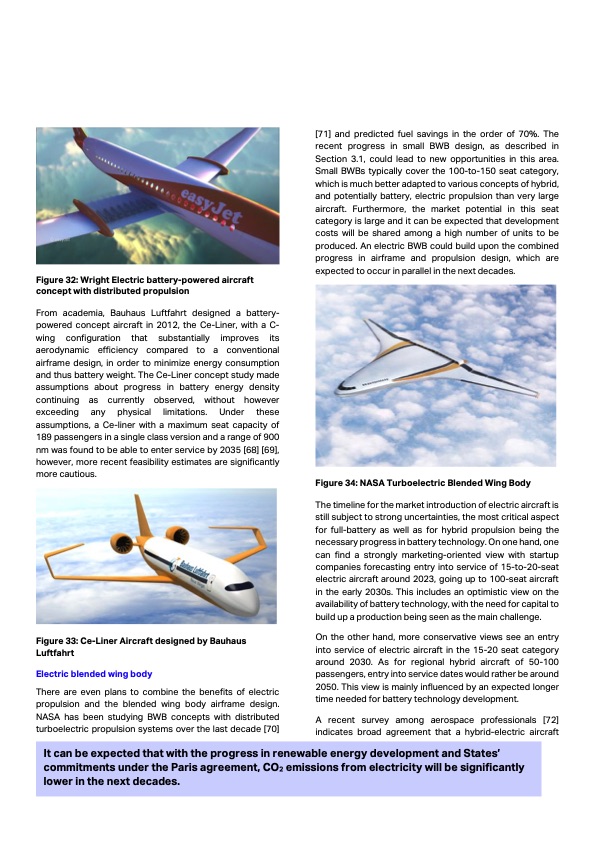
PDF Publication Title:
Text from PDF Page: 030
Figure 32: Wright Electric battery-powered aircraft concept with distributed propulsion From academia, Bauhaus Luftfahrt designed a battery- powered concept aircraft in 2012, the Ce-Liner, with a C- wing configuration that substantially improves its aerodynamic efficiency compared to a conventional airframe design, in order to minimize energy consumption and thus battery weight. The Ce-Liner concept study made assumptions about progress in battery energy density continuing as currently observed, without however exceeding any physical limitations. Under these assumptions, a Ce-liner with a maximum seat capacity of 189 passengers in a single class version and a range of 900 nm was found to be able to enter service by 2035 [68] [69], however, more recent feasibility estimates are significantly more cautious. Figure 33: Ce-Liner Aircraft designed by Bauhaus Luftfahrt Electric blended wing body There are even plans to combine the benefits of electric propulsion and the blended wing body airframe design. NASA has been studying BWB concepts with distributed turboelectric propulsion systems over the last decade [70] [71] and predicted fuel savings in the order of 70%. The recent progress in small BWB design, as described in Section 3.1, could lead to new opportunities in this area. Small BWBs typically cover the 100-to-150 seat category, which is much better adapted to various concepts of hybrid, and potentially battery, electric propulsion than very large aircraft. Furthermore, the market potential in this seat category is large and it can be expected that development costs will be shared among a high number of units to be produced. An electric BWB could build upon the combined progress in airframe and propulsion design, which are expected to occur in parallel in the next decades. Figure 34: NASA Turboelectric Blended Wing Body The timeline for the market introduction of electric aircraft is still subject to strong uncertainties, the most critical aspect for full-battery as well as for hybrid propulsion being the necessary progress in battery technology. On one hand, one can find a strongly marketing-oriented view with startup companies forecasting entry into service of 15-to-20-seat electric aircraft around 2023, going up to 100-seat aircraft in the early 2030s. This includes an optimistic view on the availability of battery technology, with the need for capital to build up a production being seen as the main challenge. On the other hand, more conservative views see an entry into service of electric aircraft in the 15-20 seat category around 2030. As for regional hybrid aircraft of 50-100 passengers, entry into service dates would rather be around 2050. This view is mainly influenced by an expected longer time needed for battery technology development. A recent survey among aerospace professionals [72] indicates broad agreement that a hybrid-electric aircraft 30 It can be expected that with the progress in renewable energy development and States’ commitments under the Paris agreement, CO2 emissions from electricity will be significantly lower in the next decades.PDF Image | Aircraft Technology Roadmap to 2050

PDF Search Title:
Aircraft Technology Roadmap to 2050Original File Name Searched:
tech-roadmap-aircraft-2050.pdfDIY PDF Search: Google It | Yahoo | Bing
NFT (Non Fungible Token): Buy our tech, design, development or system NFT and become part of our tech NFT network... More Info
IT XR Project Redstone NFT Available for Sale: NFT for high tech turbine design with one part 3D printed counter-rotating energy turbine. Be part of the future with this NFT. Can be bought and sold but only one design NFT exists. Royalties go to the developer (Infinity) to keep enhancing design and applications... More Info
Infinity Turbine IT XR Project Redstone Design: NFT for sale... NFT for high tech turbine design with one part 3D printed counter-rotating energy turbine. Includes all rights to this turbine design, including license for Fluid Handling Block I and II for the turbine assembly and housing. The NFT includes the blueprints (cad/cam), revenue streams, and all future development of the IT XR Project Redstone... More Info
Infinity Turbine ROT Radial Outflow Turbine 24 Design and Worldwide Rights: NFT for sale... NFT for the ROT 24 energy turbine. Be part of the future with this NFT. This design can be bought and sold but only one design NFT exists. You may manufacture the unit, or get the revenues from its sale from Infinity Turbine. Royalties go to the developer (Infinity) to keep enhancing design and applications... More Info
Infinity Supercritical CO2 10 Liter Extractor Design and Worldwide Rights: The Infinity Supercritical 10L CO2 extractor is for botanical oil extraction, which is rich in terpenes and can produce shelf ready full spectrum oil. With over 5 years of development, this industry leader mature extractor machine has been sold since 2015 and is part of many profitable businesses. The process can also be used for electrowinning, e-waste recycling, and lithium battery recycling, gold mining electronic wastes, precious metals. CO2 can also be used in a reverse fuel cell with nafion to make a gas-to-liquids fuel, such as methanol, ethanol and butanol or ethylene. Supercritical CO2 has also been used for treating nafion to make it more effective catalyst. This NFT is for the purchase of worldwide rights which includes the design. More Info
NFT (Non Fungible Token): Buy our tech, design, development or system NFT and become part of our tech NFT network... More Info
Infinity Turbine Products: Special for this month, any plans are $10,000 for complete Cad/Cam blueprints. License is for one build. Try before you buy a production license. May pay by Bitcoin or other Crypto. Products Page... More Info
| CONTACT TEL: 608-238-6001 Email: greg@infinityturbine.com | RSS | AMP |